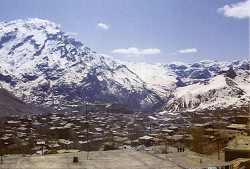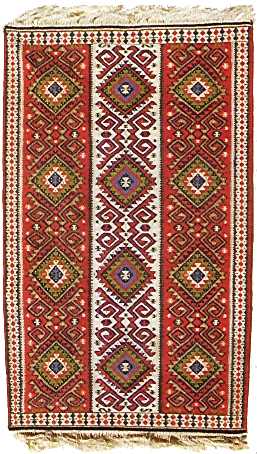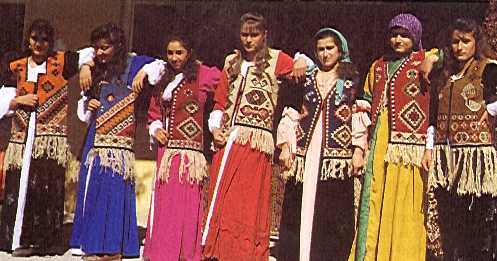KILIMS OF HAKKARI
 Long ago kilim weaving was a purely domestic handicraft practised in the
remote mountain villages of Hakkari in south-eastern Turkey. Long ago kilim weaving was a purely domestic handicraft practised in the
remote mountain villages of Hakkari in south-eastern Turkey.
Kilims were not only functional textiles used as bedspreads in cold weather, but also
showpieces illustrating the weaving skills of young girls who made them for their
trousseaus. A girl who did not know how to spin and weave intricately patterned kilims had
little hope of finding a husband, so as soon as they were old enough to hold a shuttle
girl children were seated beside their mothers at the loom and taught these age-old
skills.
 Kilims were valuable household possessions
the result of long weeks of hard work, and no one would dream of laying them on the floor
to get dusty and muddy as many of us do today. Labour was sacred and not to be thrown
under the feet. On the contrary kilims were hung on the walls to display their brilliant
designs, used as a cover over bed quilts in cold weather to lay over mattresses and bed
linen by day, or presented as gifts. A gift of a kilim was the most precious of all, and
kilims would be carefully used so that they would last for many years. Only when faded and
worn with age might they suffer the indignity of becoming a floor covering. Kilims were valuable household possessions
the result of long weeks of hard work, and no one would dream of laying them on the floor
to get dusty and muddy as many of us do today. Labour was sacred and not to be thrown
under the feet. On the contrary kilims were hung on the walls to display their brilliant
designs, used as a cover over bed quilts in cold weather to lay over mattresses and bed
linen by day, or presented as gifts. A gift of a kilim was the most precious of all, and
kilims would be carefully used so that they would last for many years. Only when faded and
worn with age might they suffer the indignity of becoming a floor covering.
Weaving kilims was a long and complex process which began with shearing the sheep. The
wool would then be cleaned and combed by workers known as kurinc before the women
took over and spun it into fine thread on spindles known as teşü. The balls of
yarn would then be dyed using vegetable dyes, which also required time and effort to
produce.
The roots, fruits and leaves collected for the various colours would be boiled up in
great cauldrons. Black, for example, was obtained from walnut leaves and shells, dark red
from the root of a plant known as rimas and yellow and blue from agirot flowers.
The five predominant colours used in kilim designs over the centuries were dark red, dark
blue, brown, black and white, with green, yellow and blue featuring only in a secondary
role.
During the winter the looms stood inside the cottages, but when summer came and the
village moved up to the mountain pastures they would be set up in the open air outside the
tents. Every motif had its meaning and could be combined in designs which enabled young
girls to express feelings and ideas which they were not free to say in words. On the loom
they wove their fears, joys and regrets in a language of symbols which they saw in nature,
dreamed up or found in the traditional repertoire. The frequently used wolf's foot and
scorpion motifs for instance represent fear; birds and flowers love, passion, abundance
and fertility ram's horns conflict and male courage. The device known as "young
bride" represents good fortune and fertility and the tree of life represents
immortality.
Today there is a burgeoning demand for Hakkari kilims, which have double rows of warp
threads onto which the design is woven by diagonal weft threads. Both warp and weft
threads are made of wool. The fineness of the warp thread is 40 per decimetre and that of
the weft threads 230 per decimetre.
Hakkari kilims are named after the tribe to which the weaver belongs. One of the most
famous types is those of Jirki tribe of which examples are to be seen in
ethnographical museums in Europe and as far afield as Japan. Another well known type is
the Herki kilims made by the Herki tribe who live mainly around Şemdinli.
In addition to the tribal name the weaver gives each kilim a name inspired by the
design the weaving style and so on. For example kilims containing the double bird motif
which usually consist of three bands are known as lüleper. Another type is known
as canbezer ("the heart grows tired") because of its complex motif. Those
with roses resembling spiders with forty legs are known as çılgül and those with
dragon motifs as hevçeker. Gülgever, gülhezar, sine, şamari and şimkubik are
examples of other kilim names.

This cottage handicraft has grown into a small industry today, and women weave kilims
for the commercial market in workshops which provide much needed work. Yarn is no longer
hand spun but supplied by a mill established with the support of Hakkari Governor's Office
in 1980. After numerous setbacks the project is going smoothly with the help of several
voluntary organisations. Nearly one thousand young girls now spend eight hours a day
weaving kilims at fifteen workshops around the province. The designs are provided by Enver
Özkahraman who has spent many years photographing the kilims of Hakkari and is well
acquainted with local culture. The kilims are sold to collectors, exporters and carpet
dealers in İstanbul's Grand Bazaar and Nuruosmaniye, Kuşadası, Cappadocia and Antalya.
In an age of cheap mass production it is crucial to preserve traditional handicrafts
before the skills passed down in families for hundreds of generations are lost for ever.
Today spreading realisation of the value of hand craftsmanship is enabling kilims to
complete with factory made substitutes and contributing to employment and the economy in
Hakkari as well as bringing traditional beauty back into our homes. |